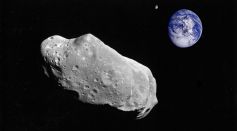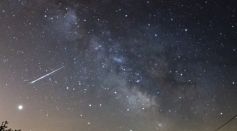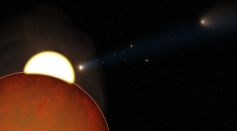Tags: Earth

Proposed Neutrino Observatory in Space Is Better Than Earth as It Captures Sun Core’s Neutrino and Other Solar Flare Activity

Potentially Hazardous Asteroid as Big as 4 Football Fields Approaching Earth at High Velocity, NASA Warns

Giant Solar Flare 20 Times the Size of Earth Visible on the Sun and Caught on Camera Ahead of Geomagnetic Storm [See]

Asteroid the Size of a 50-Story Building Will Make Closest Approach to Earth TODAY: Here's What You Need to Know From the NASA Records

Solar Flare Results In Geomagnetic Storm That May Cause Power Grid Disruption, Railway Collisions on Earth
NASA Imaging Spectrometer for Dust Mapping Across the Surface of Earth Arrives in ISS
Comet C/2017 K2 (PanSTARRS) Leaves Astronomers Confused as Space Rock Heads to Sun After Visiting Earth
Mysterious Fireballs Spotted Across US Skies: Are These Just Russian Rockets Mistaken As Meteors?

Tsunami Prediction Could Become Possible Using Data From Tonga Underwater Volcano Eruption

Comet Twice the Size Of Mount Everest Making a Safe Flyby to Earth Thursday: Watch Comet C/2017 K2 (PanSTARRS) Using a Telescope
Weird Star Sends Fast Radio Burst That Beats Like a Heartbeat Billions of Light-Years Away From Earth

Tardigrades 101: What Makes Water Bears Extremely Resilient in Space?

Black Beauty a.k.a. Northwest Africa 7034 Martian Meteorite Impact Crater on Earth Found Using Machine Learning

NASA Mars Perseverance Rover Is Looking for a Perfect Landing Spot for Sample-Return Mission to Earth [LOOK]

There’s A 10% Chance Space, Rocket Debris May Hit You on Earth; Can You Prevent It?
Comet K2 Is Heading Towards Earth This Week, NASA Says

First-Ever Exoplanet Discovered 30 Years Ago Around a Rotating Star Is an Extraordinarily Rare Pulsar

Planetesimal Theory Is Behind the Formation of Earth, Study Claims

SpaceX CEO Elon Musk Expresses Confidence About Humans Visiting Mars, Red Planet Can Help Humanity Survive From Catapstrophes on Earth
NASA’s CAPSTONE Successfully Burns First Engine Toward the Moon for 11 Minutes
Most Popular

Viruses vs Bacteria: Key Differences, How They Spread, and How We Treat Them

How Ice Cores Reveal Climate History: Insights from Paleoclimate Science and Ancient Data

Digestive System Step by Step: From Ingestion to Absorption

Science-Backed Longevity Supplements: The Best Anti-Aging Vitamins for Powerful Healthy Aging Support





